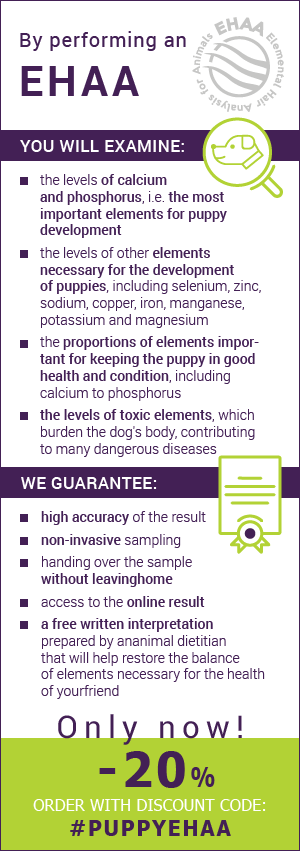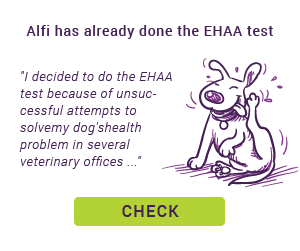Nutrition of puppies is quite a challenge for every guardian. During the first 6 months of life, the dog’s body develops intensively. Therefore, it is very important to ensure that the puppy is supplied with all the necessary nutrients. Any deficiencies can result in abnormal growth as well as health problems in adulthood. What should you pay special attention to?
BASIC INGREDIENTS
After a new puppy arrives at home, it is a good idea to stay on the food it was fed in the kennel for the first 1-2 weeks. This way, you can avoid diarrhea caused by relocation stress and a sudden change of diet. Up to about 6 months of age, meals are divided into 4 – 5 portions, and then their number is gradually reduced to 2 – 3 per day, preferably at fixed times (the number of meals is a very individual matter, and you can start reducing it earlier). Food for growing dogs should be characterized by high digestibility and biological value. This is a precondition for better digestibility of the nutrients it contains.
In the case of growing dogs, the caloric content of meals is very important. The energy requirement of puppies is twice as high as that of adult dogs of the same body weight and depends on age and breed. It is related to the very intensive growth and development of the organism. This does not mean, however, that ad libitum feeding is acceptable. Excess calories lead to the multiplication of fat cells, which may result in obesity in later years. Remember that fat is also a source of n-3 and n-6 polyunsaturated fatty acids. They support the proper development of the brain as well as the sense of sight and hearing. Therefore, it is worth including omega-3 oils from small sea fish or salmon in your puppy’s diet.
 In order to build new tissues in a growing organism, it is also necessary to have good quality protein, i.e., high digestibility and the content of exogenous (essential) amino acids. Therefore, it is worth choosing animal products as the source of this ingredient. The total protein content in the food should be 25 g / 100 g dry food for puppies up to 14 weeks of age and 20 g / 100 g dry food after 14 weeks of age.
In order to build new tissues in a growing organism, it is also necessary to have good quality protein, i.e., high digestibility and the content of exogenous (essential) amino acids. Therefore, it is worth choosing animal products as the source of this ingredient. The total protein content in the food should be 25 g / 100 g dry food for puppies up to 14 weeks of age and 20 g / 100 g dry food after 14 weeks of age.
CALCIUM AND PHOSPHORUS
Of all the macro- and microelements in puppy nutrition, calcium and phosphorus play the most important role in shaping the skeleton of a young organism. Until about 10 months of age, dogs passively absorb calcium from the gastrointestinal tract. This means that the amount of calcium absorbed is practically the same as its amount in food. Therefore, any excess of this element in the food will be tantamount to its excess in the body and may contribute to the development of bone and cartilage diseases. Keep this in mind when deciding to feed your dog with complete food. They are properly balanced in terms of all ingredients and additional supplementation is not needed.
An overdose of calcium is especially dangerous for large and giant breed dogs. Contrary to popular opinion, increasing the proportion of this element in their diet will not have a positive effect on the growth and structure of a puppy’s bones. On the contrary, this can contribute to a slower growth rate, as well as diseases such as hip dysplasia, osteochondrosis, rickets and secondary nutritional hyperparathyroidism.
The optimal content of calcium in dry food for dogs of small and medium breeds is 0.7-1.7%, and for large breeds 0.7-1.2%. In contrast, the correct ratio of calcium to phosphorus is 1-1.5: 1 for large breeds and 1-1.8: 1 for others.
For dogs fed home cooked meals, powdered eggshells, calcium from sea algae, calcium carbonate, or calcium citrate are good sources of calcium.
OTHER MINERALS
You should also not forget about the other elements. The demand for them is much higher in puppies than in adult dogs. The minimum contents of these components are presented in the table.
Minimum content of minerals in food for puppies (FEDIAF, 2019)
| MINERAL NUTRITION |
MINIMUM CONTENT IN FOOD |
|
MACROELEMENTS (g/100g dry basis)
|
| Sodium |
0,22 |
| Potassium |
0,44 |
| Magnesium |
0,04 |
| Chlorine |
0,33 |
|
MICROELEMENTS (mg/100g dry basis)
|
| Iron |
8,80 |
| Zinc |
10,0 |
| Copper |
1,10 |
| Manganese |
0,56 |
| Jodine |
0,15 |
| Selenium |
40,0 |
Insufficient amounts of the macro and micronutrients listed above usually result in delayed growth. In the case of iron, there are also difficulties remembering commands in young dogs. There is also microcytic hypochromatic anemia, which manifests itself, among others, with diarrhea, pale mucous membranes, ecchymosis, and tarry faeces. In puppies deficient in potassium, paralysis of the muscles of the pelvic limbs and ventral flexion of the neck can be observed. On the other hand, in individuals with magnesium deficiency – muscle tremors and lower bone mineralization. Too low sodium concentration in the body is manifested by an acceleration of the heart rate and increased thirst. The effects of zinc deficiency – changes on the skin of the fingertips, and copper – discoloration of the hair – are easy to notice.
The source of most of the micro and macro elements are products of animal origin, in particular meat and offal (hearts, kidneys, spleen, liver) rich in copper, selenium, and iron, as well as fish and crustaceans in which iodine is present.
SUMMATION
The first months of a dog’s life are a period of intense growth and development. Nutrition at this stage plays a key role in shaping the young organism. Any mistakes made may result in health problems that will reveal themselves in the adult life of our pets. That is why it is so important to choose the right food intended for puppies or, in the case of meals prepared by yourself, to use appropriate supplements. To make sure that the puppy is developing properly, it is worth checking his or her body weight regularly. You can also use the EHAA test, which will allow you to determine the content of minerals in a dog’s coat and, on this basis, supplement any deficiencies.
Katarzyna Żmuda, M.Sc., engineer, specialist in animal nutrition and dietetics
 1. Ceregrzyn M., Barszczewska B., Lechowski R. 2016. Podstawy żywienia psów i kotów. Wydawnictwo Edra Urban & Partner. Wrocław.
1. Ceregrzyn M., Barszczewska B., Lechowski R. 2016. Podstawy żywienia psów i kotów. Wydawnictwo Edra Urban & Partner. Wrocław.
2. Dobenecker B. 2002. Influence of calcium and phosphorus intake on the apparent digestibility of these minerals in growing dogs. The Journal of Nutrition, nr 132(6)
3. FEDIAF. 2019. Nutritional Guidelines For Complete and Complementary Pet Food for Cats and Dogs (Wytyczne żywieniowe dotyczące pełnoporcjowych i uzupełniających karm dla kotów i psów). The European Pet Food Industry Federation.
4. Hołda K. 2016. Dodatki żywieniowe w okresie wzrostu. Dog & Sport, nr 2, s. 64-65.
5. Hołda K., Głogowski R. 2016. Żywienie szczeniąt i psów młodych. VetPersonel, nr 2, s. 54-57.
6. Jank M., Wilczak J. 2011. Jak żywić psa. Zdrowa dieta, smakołyki, przygotowanie karmy. Multico Oficyna Wydawnicza. Warszawa.
7. Lauten S. D. 2006. Nutritional Risks to Large-Breed Dogs: From Weaning to the Geriatric Years. Veterinary clinics small animal practice, nr 36, s. 1345-1359.
8. Mirowski A. 2014. Żywieniowe czynniki ryzyka chorób układu kostno-stawowego u szczeniąt psów ras dużych i olbrzymich. Życie weterynaryjne, nr 89(2), s. 125-127.
9. Sygocki C. Minerały i witaminy dla psa potrzebne do utrzymania pełni zdrowia. https://vetexpert.eu/blog/skladniki-mineralne-i-witaminy-czego-potrzebuje-twoj-piesdo-utrzymania-pelni-zdrowia.
10. Wilczak J., Jank M. 2013. Żywienie psów rosnących ras dużych – cz. I. Weterynaria w Praktyce, nr 11-12, s. 78-83.
11. Witkowska O. 2015. Żywienie a behawior psów i kotów. Życie weterynaryjne, nr 90(9), s. 573-576.















